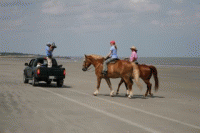Georgia- Sea Island Nature Ride



I just got back from riding with Stacia Hendricks, a naturalist on Sea Island, who took me out for a nature ride on the beaches and into the varied ecosystems of Sea Island. I rode Charlie, a very large Belgian Draft horse. At almost 18 hands high, I would certainly be getting a bird's eye view of things during our journey.
We rode over the Black Banks River and hit the wooded trails that lead to the wide, sandy beaches of Sea Island. There is a rich diversity of bird life on Sea Island. We passed an osprey nest at the beginning of the maritime forest, and Stacia and I stopped to look up at the proud mama.
Once we hit the beach, we decided to canter a bit. We were headed towards the stakes that mark a loggerhead turtle nest a ways down the beach. I signaled Charlie, who took off into a canter. Stacia was riding a smaller Quarter Horse. As Charlie is so big, we could actually trot along and keep up with her horse's canter. Charlie had a large trot, so I decided that cantering would be a bit more comfortable. Stacia's horse had no trouble keeping up and our horses seemed to get a little competitive at one point, hoping to race.
I held Charlie back a bit, noticing that we were nearing the nest. Loggerhead turtles are an endangered species. Stacia talked a bit about how she and others on the island work to help the turtles thrive and survive.
Keeping house lights and flashlights out is important on these islands where the turtles nest, because when the sea turtles finally hatch out of their eggs, they follow the moonlight to the water to swim away. These turtles have some sort of internal GPS, because turtles that are born in one spot will return to the spot where they were born when it is time for them to have babies. The journey to the sea leaves a lasting imprint, and they they always go back to that spot.
The journey from their nest to the ocean also prepares them to swim, as the turtles will stretch their muscles on the way to the water.
From there, Charlie and I carefully navigated on a pathway onto the trails leading into the dunes. Here, the rich vegetation was even more evident. This vegetation helps anchor the sand in place and keep the dunes from eroding. The wind was pretty strong as we rode onward. I could see why the trees leaned away from the water. Many of the trees appeared to be manicured or like miniature bonsai trees. Stacia explained that the wind causes this process.
We stayed on the trails as we rode through the dunes. With the subtropical environment comes added plant life like cactus and these pretty white flowers, which are actually sting as a defense mechanism.
Stacia explained that on the island many of the plants have special properties, such as the toothache tree. Stacia grabbed a leaf off of the tree and handed it back to me. It smelled minty. If you were to chew on a mouthful of these, your mouth would go numb, thus good for toothaches.
Stacia got really excited, as she pointed out the rare and elusive red-billed oyster catcher. This small bird is not yet on the endangered list, but it's listed as a bird of concern, as its numbers are dwindling.
We were riding through a couple of different habitats, as we moved from the beach through the dunes and into the marsh. As we rode down the trail, a mass of Fiddler Crabs scurried out of our way. The male crabs have a large claw that is used to attract the females to mate.
I was learning a lot as we continued to ride. Back on the beach, Stacia and I opted for another fast ride down the shore. The sand appeared to have thick black lines in it in many places. Stacia said that this sand is black because it is filled with minerals, which actually came from the Appalachian Mountains.
I looked at the ocean, as we continued our ride, hoping to catch a glimpse of the dolphins who had followed us on our trek the other day. No such luck. The oceans off of Sea Island are teeming with life, and Stacia pointed out more of what I could and couldn't see as we continued down the shore. What a great way to discover the island's natural history--on horseback!
Darley Newman is the host of the Emmy Award-winning Public Television series Equitrekking®, which takes viewers on horseback riding vacations around the world. Equitrekking is broadcast on PBS stations and on international networks in over 30 countries.
Watch the Equitrekking video promos and purchase Equitrekking DVDs in our Store. Learn about equestrian vacations and book a horseback riding vacation at EquitrekkingTravel.com





